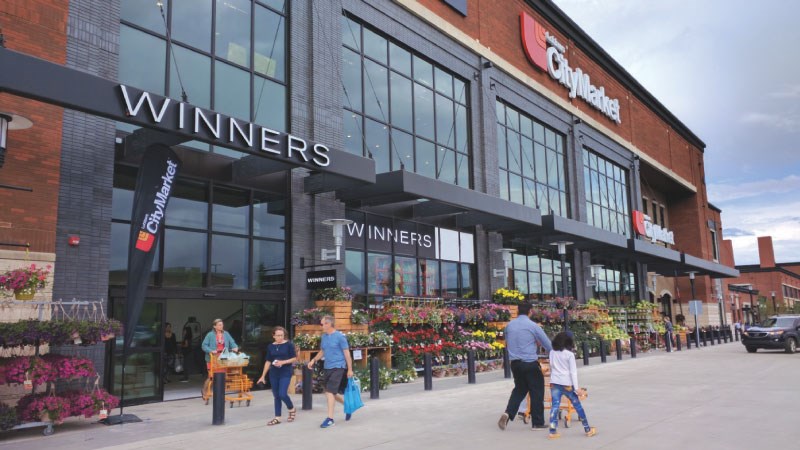In what was a surprise to some, Edmonton commercial real estate sale volumes increased 12 per cent in 2016 to $2.3 billion. This year will see a mixed bag as Alberta’s capital city reboots from the decline in oil prices: higher vacancies in the office sector, a solid industrial sector, a slipping multi-family market and growing confidence in retail real estate, according to analysts.
The trends for 2017 were seen in 2016, the key being a building momentum as the year unfolded, finishing off with an 81 per cent year-over-year increase in the fourth quarter, reports Altus Group.
Three asset classes saw their total transaction value increase in 2016. The lead was the retail sector, which had its best year since 2013, with 101 transactions worth a total of $524 million, up a startling 172 per cent from a year earlier.
The retail strength, in fact, has shaken dust off some downtown development plans. This includes a new look at the Quarters, 100 acres that extend east from 97 Street to 92 Street and south from 103A Avenue to the river valley.
Right now it is a modest mix of commercial space and low-income homes with a population of about 2,400. City of Edmonton planners, however, envision it becoming an “environmentally sustainable, walkable, diverse community” with chic shops, office space and homes for 20,000.
While the overall vision has stalled, some investors have stepped in to push it forward.
Jim Olivieri, the owner and founder of National Cappuccino, has bought and renovated an aging building near 102 Avenue and 9 Street into a retail centre. The facade was rebuilt, the bricks were washed, windows added, and the construction was brought up to code. The building, steps away from the Edmonton Art Gallery and the Royal Alberta Museum, completed renovations this year. “The Quarters has lots of potential,” Olivieri said.
Avison Young is also bullish on Edmonton’s overall downtown shopping scene.
“The retail market shows few signs of fading,” the agency remarked in a 2017 forecast.
It noted that Edmonton’s Brewery District is in the final stages of development and “has become a catalyst for downtown retail development.” Loblaws has opened a 40,000-square-foot store in the district, and other key tenants include Winners, Shoppers Drug Mart and Starbucks. The Brewery District completes this year.
Edmonton’s industrial sector also gained momentum last year that could carry it into 2017. The industrial market recorded 142 transactions worth a total of $607 million, a 47 per cent increase over the 2015 total and made up 38.7 per cent of total commercial sales volume in the fourth quarter.
The overall industrial vacancy rate ended last year at 6.4 per cent, unchanged from 2015.
Analysts expect the industrial market to make a tempered recovery throughout 2017. “Large capital investment in Alberta’s oil infrastructure will help kick-start this process,” according to Avison Young.
Suncor Energy has announced a $5.2 billion spending program, and Cenovus Energy earmarked $1.4 billion to be invested in its oil sands projects in 2017, the agency noted. Approval and start of the Trans Mountain expansion pipeline project, which will pipe more Alberta oil to the Greater Vancouver coast, should also benefit the industrial sector.
Edmonton’s downtown office towers, though, are posting double-digit vacancies and are not expected to tighten up this year. The total downtown vacancy hit 17.4 per cent in the fourth quarter, according to Jones Lang LaSalle, and spiked over 20 per cent in the financial district.
This is largely due to the unprecedented one-year delivery of 1.2 million square feet of new downtown office space last year. A further 800,000 square feet is still under construction, including the 600,000-square-foot Stantec tower that opens in 2018.
“Local landlords will be faced with difficult decisions this year,” Avison Young understated, especially those with aging space and facing increased competition from the new towers.
Multi-family
Sales of rental apartment buildings in 2016 also send a warning signal of what to expect in the multi-family sector in 2017. Sales and volume were down, with 61 transactions worth $336 million, a 12 per cent decline from 2015.
Edmonton landlords are feeling the sting of the economic slowdown. According to the latest Canada Mortgage and Housing Corp. rental market report, the rental vacancy in Edmonton reached 7.1 per cent in 2016, compared to a Canada-wide average of 3.7 per cent. Average rents have already dropped about 2 per cent.
There are also a lot of new rentals being built. From July 2015 to June 2016, 3,162 new rental apartments were completed, and more than 2,000 rental apartments are under construction, noted Julie Egbert, an associate with Re/Max Commercial in Edmonton.



